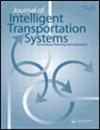An anti-disturbance lane-changing trajectory tracking control method combining extended Kalman filter and robust tube-based model predictive control
IF 2.8
3区 工程技术
Q3 TRANSPORTATION
Journal of Intelligent Transportation Systems
Pub Date : 2025-05-04
DOI:10.1080/15472450.2024.2315136
引用次数: 0
Abstract
This paper proposes a trajectory tracking control method combining extended Kalman filter (EKF) and robust tube-based model predictive control (RTMPC) methods to improve the anti-disturbance capability during lane-changing maneuver of automated vehicles. A time-based quintic polynomial function is introduced for the implementation of trajectory planning to obtain the desired reference trajectory. The planned trajectory is input to the nominal system-oriented model predictive controller (MPC) in RTMPC for optimization to obtain the optimal control of the nominal system. The EKF collects the state measurements of the current instant and the optimal state estimates of the previous instant, and performs filtering to obtain the optimal state estimates of the current instant. The optimal estimate of the current state and the current state of the nominal system are input into the auxiliary control law of RTMPC to obtain the control of the actual system. Comparative numerical simulation experiments are conducted to analyze robustness and sensitivity of the proposed method. The results show that the control method combining EKF and RTMPC can optimize the trajectory tracking performance of the vehicle system, especially in the lateral displacement and the yaw-rate control. When the amplitude of measurement noise reaches the maximum, the optimization effect of lateral control is most significant in experiments. And the optimization effect in the control of lateral displacement and yaw angle continues to enhance with the increase of measurement disturbance. Therefore, this study can provide a reference for the anti-interference lane change trajectory tracking strategy of automated vehicles in the future.
结合扩展卡尔曼滤波器和鲁棒管基模型预测控制的抗干扰变道轨迹跟踪控制方法
本文提出了一种结合扩展卡尔曼滤波器(EKF)和鲁棒性管基模型预测控制(RTMPC)方法的轨迹跟踪控制方法,以提高飞机的抗干扰能力。
本文章由计算机程序翻译,如有差异,请以英文原文为准。
求助全文
约1分钟内获得全文
求助全文
来源期刊
CiteScore
8.80
自引率
19.40%
发文量
51
审稿时长
15 months
期刊介绍:
The Journal of Intelligent Transportation Systems is devoted to scholarly research on the development, planning, management, operation and evaluation of intelligent transportation systems. Intelligent transportation systems are innovative solutions that address contemporary transportation problems. They are characterized by information, dynamic feedback and automation that allow people and goods to move efficiently. They encompass the full scope of information technologies used in transportation, including control, computation and communication, as well as the algorithms, databases, models and human interfaces. The emergence of these technologies as a new pathway for transportation is relatively new.
The Journal of Intelligent Transportation Systems is especially interested in research that leads to improved planning and operation of the transportation system through the application of new technologies. The journal is particularly interested in research that adds to the scientific understanding of the impacts that intelligent transportation systems can have on accessibility, congestion, pollution, safety, security, noise, and energy and resource consumption.
The journal is inter-disciplinary, and accepts work from fields of engineering, economics, planning, policy, business and management, as well as any other disciplines that contribute to the scientific understanding of intelligent transportation systems. The journal is also multi-modal, and accepts work on intelligent transportation for all forms of ground, air and water transportation. Example topics include the role of information systems in transportation, traffic flow and control, vehicle control, routing and scheduling, traveler response to dynamic information, planning for ITS innovations, evaluations of ITS field operational tests, ITS deployment experiences, automated highway systems, vehicle control systems, diffusion of ITS, and tools/software for analysis of ITS.

 求助内容:
求助内容: 应助结果提醒方式:
应助结果提醒方式:


